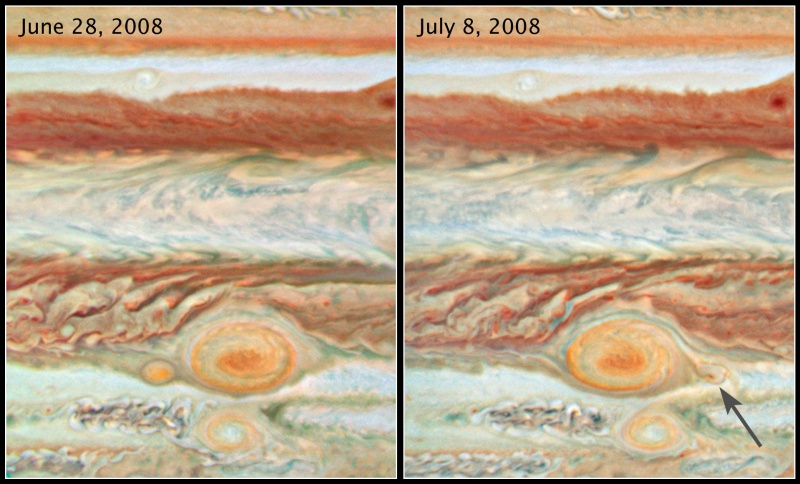Credit & Copyright: NASA,
ESA,
Amy Simon-Miller
(Goddard
Space Flight Center),
N. Chanover (NMSU),
G. Orton (JPL)
Explanation:
These detailed Hubble Space Telescope close-ups
feature Jupiter's
ancient swirling storm system
known as the
Great Red Spot.
They also
follow the progress of two newer storm
systems that have grown to take on a similar reddish hue:
the smaller "Red Spot Jr." (bottom), and smaller still,
a "baby red spot".
Red Spot Jr. was seen to form
in
2006, while the smaller spot was just identified
earlier this year.
For scale,
the Great Red Spot has almost twice the diameter
of planet Earth.
Moving
horizontally from left to right past the Great Red Spot,
Red Spot Jr. clearly went below the larger storm,
but the smaller spot was pulled in.
Emerging on the right, the baby spot's stretched and now paler
shape is indicated by the arrow in the frame from July 8.
It is expected that the baby red spot will be pulled back and
merge, becoming part of the giant storm system.
1999 2000 2001 2002 2003 2004 2005 2006 2007 2008 2009 2010 2011 2012 2013 2014 2015 2016 2017 2018 2019 2020 2021 2022 2023 2024 2025 |
Yanvar' Fevral' Mart Aprel' Mai Iyun' Iyul' Avgust Sentyabr' Oktyabr' Noyabr' Dekabr' |
NASA Web Site Statements, Warnings, and Disclaimers
NASA Official: Jay Norris. Specific rights apply.
A service of: LHEA at NASA / GSFC
& Michigan Tech. U.
|
Publikacii s klyuchevymi slovami:
Jupiter - red spot - storm - Yupiter - Bol'shoe Krasnoe Pyatno
Publikacii so slovami: Jupiter - red spot - storm - Yupiter - Bol'shoe Krasnoe Pyatno | |
Sm. takzhe:
Vse publikacii na tu zhe temu >> | |
